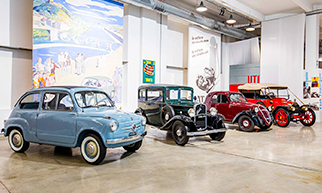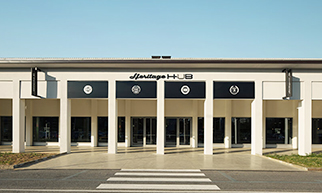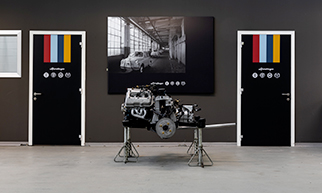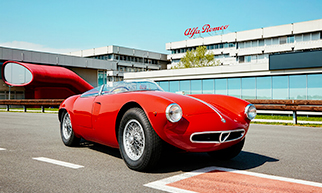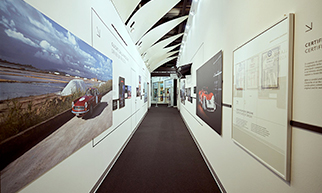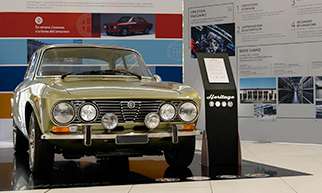Stellantis Heritage will be among the highlights of Auto e Moto d’Epoca
At the Auto e Moto d’Epoca show, scheduled in Bologna from October 23 to 26, Stellantis Heritage presents three cars that embody the history and passion of the Italian automotive industry. From the Heritage Hub in Turin and the Alfa Romeo Museum in Arese come three exceptional models: the Lancia D25 (1954), Fiat-Abarth 750 Record (1956), and Alfa Romeo Scarabeo (1966). Three unique vehicles, different in era and design philosophy, yet driven by the same mission: to push beyond the limits of engineering and design.
Long committed to preserving and promoting its industrial and cultural heritage, the Group’s department has chosen Europe’s leading event dedicated to historic motoring to offer the public an immersive experience, highlighting three fundamental, inseparable themes in its story: Vision, Velocity, and Victory. This unifying thread spans the decades and connects iconic brands such as Abarth, Lancia, and Alfa Romeo, witnesses to a tradition built on courage, inimitable style, and a determination to look to the future.
Roberto Giolito, Head of Stellantis Heritage, comments: “By taking part in Auto e Moto d’Epoca, we celebrate our museum and reaffirm Italy’s central role in the history of the automobile. The three cars on display are not mere signs of the past but authentic expressions of a creative spirit, tangible proof of the Italian drive to innovate with style, courage, and imagination.”
Two museums, one great passion
Two of the cars on display, the Fiat-Abarth 750 Record and the Lancia D25, come from the Heritage Hub collection in Turin, housed in the historic Mirafiori industrial complex, the heart of Italy’s automotive industry. It is a unique place where past and future meet across more than 15,000 square meters dedicated to automotive history. Its permanent exhibition spans Fiat, Lancia, Abarth, Alfa Romeo, Autobianchi, and Jeep, telling the story of technical and stylistic breakthroughs in an unparalleled collection. Enhancing the visitor experience is the impressive Engines Area, which retraces more than a century of automotive engineering through powertrains.
Alongside these treasures is the Alfa Romeo Scarabeo, from the remarkable collection of the Alfa Romeo Museum in Arese. Inaugurated in 1976 and conceived to highlight the brand’s extraordinary ability to turn every model into a work of art, the Museum showcases not just the history but also the enduring values of Alfa Romeo. Through in-depth sections, curiosities, archival material, multimedia, and interactive stations, enthusiasts and scholars alike can discover the most authentic DNA of Alfa Romeo.
Lancia D25, 1954
From the heart of the Heritage Hub emerges the Lancia D25, an evolution of the celebrated D24, the racing spider that dominated major international competitions such as the Carrera Panamericana, Mille Miglia, and Targa Florio. Designed by the renowned Vittorio Jano, the D25 represents one of the highest expressions of 1950s sports engineering. Powered by a 60° V6 of 3,750 cc, delivering 305 hp at 6,500 rpm, the D25 boasted a top speed of 300 km/h: truly ahead of its time. The bodywork, featuring enclosed wheels and two seats, is built around a chromoly steel tubular spaceframe, with the engine integrated into the frame as a structural element. For optimal weight distribution, the clutch, gearbox, differential, and inboard brakes are all positioned at the rear. Independent front suspension with a transverse leaf spring (a layout later adopted on the Flavia and Fulvia), and a De Dion rear axle with two cantilever-type leaf springs. Built by Pininfarina, the car on display in Bologna is the only surviving example, which never had the opportunity to race, as Lancia chose to focus exclusively on Formula 1. Nevertheless, it remains an outstanding and precious testament to the technical refinement and sporting vision that made Lancia unforgettable.
Fiat-Abarth 750 Record, 1956
First of the three cars to take the spotlight at Bologna’s Auto e Moto d’Epoca is the Fiat-Abarth 750 Record. Designed by Franco Scaglione, a lodestar of automotive design, and conceived in pursuit of maximum aerodynamic efficiency, this car ranks among Carlo Abarth’s most astonishing achievements. With light, razor-edged lines seemingly made to slice through the air, the 750 Record anticipated solutions that would later become standard in production cars. This model wasn’t just about a show-stopping aesthetic: beneath its sleek form lays a cutting-edge technical package, proven by six records set in 1956, the year in which Abarth achieved a string of endurance and speed achievements. On June 18 at Monza, it broke the 24-hour record, covering 3,743 km at an average of 155 km/h. From June 27 to 29, on the same circuit, it set further records on the 5,000 and 10,000 km, 5,000 miles, and 48 and 72 hours. The same car was later rebodied by Zagato in two versions: the Fiat-Abarth 750 Zagato (1956) and the Fiat-Abarth 750 GT Zagato (1956). The “roar” of this vehicle even reached Franklin Delano Roosevelt Jr., son of the U.S. President, who came to Italy to sign an exclusive distribution agreement with Abarth.
Alfa Romeo Scarabeo, 1966
Completing this trio of excellence is the Alfa Romeo Scarabeo, one of the most original and fascinating prototypes in the history of the Milanese brand. Built in 1966 and equipped with the twin-cam four-cylinder from the Giulia Sprint GTA, the Scarabeo introduced cutting-edge technical solutions: an engine mounted transversely in a rear-mid position, in a single unit with the clutch and gearbox. Its suspension adopted the front layout used on Renault’s R8, a company with which Alfa Romeo maintained industrial and commercial ties, while its tubular chassis employed an ambitious solution, also on the Tipo 33: large tubular side members alongside the cockpit housing the fuel tanks. With bodywork produced by O.S.I. (Officine Stampaggi Industriali) of Borgaro Torinese, the Scarabeo debuted that autumn at the Paris Motor Show, stealing the spotlight with its refined, streamlined lines, truncated tail, and surprising absence of doors, replaced by access to the cabin through a forward-tilting roof. The vehicle on display is the second, simplified prototype, featuring left-hand drive, a conventional windscreen, and doors: a truly unique and perfectly preserved model from the Alfa Romeo Museum in Arese, where its legacy is safeguarded.
More info on
autoemotodepoca.com